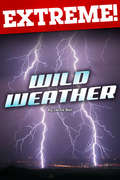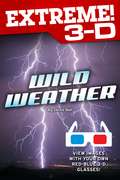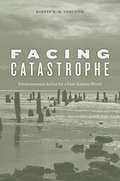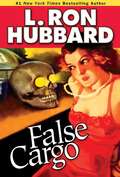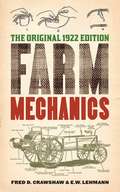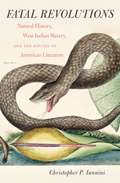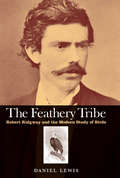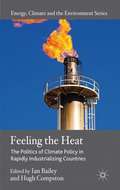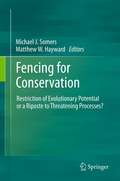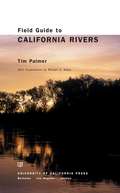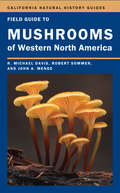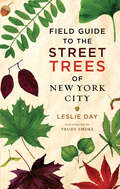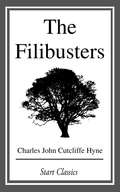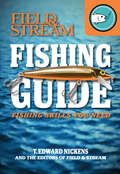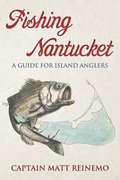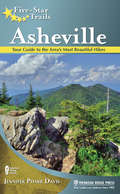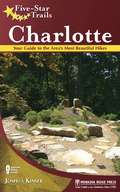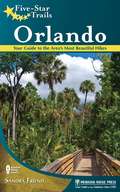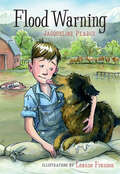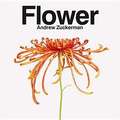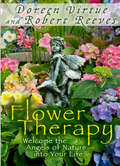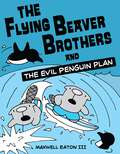- Table View
- List View
Extreme: Wild Weather
by Jackie BallExperience the most awesome power on Earth: wild weather! From destructive thunderstorms to devistating tornados, wild weather can appear out of nowhere and uproot trees, tear apart houses, and bring cities to a standstill. Extreme: Wild Weather is packed with dramatic photos and the insight you need to understand droughts, ice storms, tsunamis, and more.
Extreme 3-D: Wild Weather
by Jackie BallExperience the most awesome power on Earth: wild weather! From destructive thunderstorms to devistating tornados, wild weather can appear out of nowhere and uproot trees, tear apart houses, and bring cities to a standstill. Extreme 3-D: Wild Weather is packed with dramatic 3-D photos and the insight you need to understand droughts, ice storms, tsunamis, and more.
Facing Catastrophe: Environmental Action for a Post-Katrina World
by Robert R. VerchickAs Hurricane Katrina vividly revealed, disaster policy in the United States is broken and needs reform. What can we learn from past disasters—storms, floods, earthquakes, tsunamis, landslides, and wildfires—about preparing for and responding to future catastrophes? How can these lessons be applied in a future threatened by climate change? In this bold contribution to environmental law, Robert Verchick argues for a new perspective on disaster law that is based on the principles of environmental protection. His prescription boils down to three simple commands: Go Green, Be Fair, and Keep Safe. “Going green” means minimizing exposure to hazards by preserving natural buffers and integrating those buffers into artificial systems like levees or seawalls. “Being fair” means looking after public health, safety, and the environment without increasing personal and social vulnerabilities. “Keeping safe” means a more cautionary approach when confronting disaster risks. Verchick argues that government must assume a stronger regulatory role in managing natural infrastructure, distributional fairness, and public risk. He proposes changes to the federal statutes governing environmental impact assessments, wetlands development, air emissions, and flood control, among others. Making a strong case for more transparent governmental decision-making, Verchick offers a new vision of disaster law for the next generation.
Falcon
by Tim JessellA young boy imagines what it would be like to fly as a falcon and see the world from on high. Soaring through the skies, he describes the sights and sounds of the world below. From snow-capped mountains to lush valleys, over rolling ocean and up rocky cliffs, Falcon will awaken the senses of every reader.From the Hardcover edition.
False Cargo
by L. Ron HubbardDiscover intrigue. Brent Calloway is hired by an insurance firm to board a cargo vessel undercover and ensure it makes its way to San Diego in one piece. Once the voyage is underway, Calloway finds fraud, a pattern of organized scuttlings and the true fate of another vessel captained by an old friend. But when Calloway's true identity is revealed, he must fight for his life--and the real danger begins. ALSO INCLUDES THE ADVENTURE STORY "GROUNDED""...one of the great pulp writers, with colorful prose, lively action writing, exotic locales, fresh variations on standard characters and situations, and well-constructed plots."--Ellery Queen
Farm Mechanics: The Original 1922 Edition (Classic Reprint Ser.)
by E W. Lehmann Fred D. CrawshawAn essential agricultural text originally published in 1922, Farm Mechanics is exactly that: a detailed but easy-to-understand manual outlining all the important aspects of working the land.The guide is broken up into sections that cover every aspect of farm work, from woodworking and cement-laying to farm machinery repair. Informative and easy to understand, with close to five hundred illustrations and photographs, Farm Mechanics is both a historical reference for those interested in the history of agriculture and a commonsense tool that outlines essential agricultural skills.For those who want to know more about the golden days of farming, there are plenty of details here to paint a vivid picture of early-twentieth-century farming in the United States, accompanied by detailed photos and illustrations of farm equipment and practices in action.But this isn't just a book of theoretical practices for curious historians either--while some of the skills explained here might admittedly seem inapplicable for modern use (due to advances in technology most farmers aren't taking the time to learn blacksmithing, for instance), other sections, like cement and concrete or rope and harness work for farm animals, contain tools and advice that are still indispensable to the modern-day farmer.
Fatal Revolutions
by Christopher P. IanniniDrawing on letters, illustrations, engravings, and neglected manuscripts, Christopher Iannini connects two dramatic transformations in the eighteenth-century Atlantic world--the emergence and growth of the Caribbean plantation system and the rise of natural science. Iannini argues that these transformations were not only deeply interconnected, but that together they established conditions fundamental to the development of a distinctive literary culture in the early Americas. In fact, eighteenth-century natural history as a literary genre largely took its shape from its practice in the Caribbean, an oft-studied region that was a prime source of wealth for all of Europe and the Americas. The formal evolution of colonial prose narrative, Ianinni argues, was contingent upon the emergence of natural history writing, which itself emerged necessarily from within the context of Atlantic slavery and the production of tropical commodities. As he reestablishes the history of cultural exchange between the Caribbean and North America, Ianinni recovers the importance of the West Indies in the formation of American literary and intellectual culture as well as its place in assessing the moral implications of colonial slavery.
The Feathery Tribe
by Daniel LewisAmateurs and professionals studying birds at the end of the nineteenth century were a contentious, passionate group with goals that intersected, collided and occasionally merged in their writings and organizations. Driven by a desire to advance science, as well as by ego, pride, honor, insecurity, religion and other clashing sensibilities, they struggled to absorb the implications of evolution after Darwin. In the process, they dramatically reshaped the study of birds. Daniel Lewis here explores the professionalization of ornithology through one of its key figures: Robert Ridgway, the Smithsonian Institution’s first curator of birds and one of North America’s most important natural scientists. Exploring a world in which the uses of language, classification and accountability between amateurs and professionals played essential roles, Lewis offers a vivid introduction to Ridgway and shows how his work fundamentally influenced the direction of American and international ornithology. He explores the inner workings of the Smithsonian and the role of collectors working in the field and reveals previously unknown details of the ornithological journalThe Aukand the untold story of the color dictionaries for which Ridgway is known.
Feeling the Heat
by Ian Bailey Hugh CompstonTo avoid uncontrolled climate change, greenhouse gas emissions will have to be brought under control by major emitters outside the affluent West. The authors investigate the political obstacles in BRIC countries and what their governments could do to strengthen climate policies without incurring serious political damage.
Fencing for Conservation
by Michael J. Somers Matthew HaywardThe conflict between increasing human population and biodiversity conservation is one of the IUCN's key threatening processes. Conservation planning has received a great deal of coverage and research as a way of conserving biodiversity yet, while theoretically successful, it has never been tested. Simple lines on maps to illustrate conservation areas are unlikely to be successful in the light of human encroachment. It may be that some form of overt display is necessary to ensure the protection of reserves. This may be signage, presence of guards/rangers or physical fencing structures. The need for some form of barrier goes beyond restricting human access. The megafauna of Africa pose a genuine threat to human survival. In southern Africa, fences keep animals in and protect the abutting human population. Elsewhere, fencing is not considered important or viable. Where poverty is rife, it won't take much to tip the balance from beneficial conservation areas to troublesome repositories of crop-raiders, diseases and killers. Conversely, in New Zealand fences are used to keep animals out. Introduced species have decimated New Zealand's endemic birds, reptiles and invertebrates, and several sites have been entirely encapsulated in mouse-proof fencing to ensure their protection. Australia faces the same problems as New Zealand, however surrounds its national parks with cattle fences. Foxes and cats are free to enter and leave at will, resulting in rapid recolonisation following poisoning campaigns. How long will these poison campaigns work before tolerance, aversion or resistance evolves in the introduced predator populations?
Field Guide to California Rivers
by Tim PalmerAward-winning author, naturalist, and conservationist Tim Palmer presents the world of California rivers in this practical and inspiring field guide. Loaded with tips on where to hike, fish, canoe, kayak, and raft, it offers an interpretive approach that reveals geology, plant and wild life, hydrologic processes, and other natural phenomena. Palmer reports on conservation with a perspective from decades of personal engagement. More than 150 streams are featured, 50 riparian species are illustrated, and 180 photos show the essence of California's rivers. Palmer brings a natural history guide, a recreation guide, and an introduction to river ecology together in one illuminating volume; it belongs in every river lover's book collection, boat, and backpack.
Field Guide to Mushrooms of Western North America
by R. Michael Davis John A. Menge Robert SommerCalifornia and the Western States are rich in abundant and diverse species of mushrooms. Amateur mushroom collectors and mycologists alike will find over 300 species of the region's most common, distinctive, and ecologically important mushrooms profiled in this comprehensive field guide. It provides the most up-to-date science on the role of fungi in the natural world, methods to identify species, and locations of mushroom habitats. With excellent color illustrations showing top and side views of mushrooms of the Western States and a user-friendly text, it is informative but still light enough to be carried into the woods. When used to identify mushrooms, keys bring the reader to individual species, with a descriptive text providing cues for identifying additional species. Mushrooms common in urban landscapes are included, which is especially useful for the casual encounter with backyard fungi. The guide also provides a table of both old and new species names, and information on edibility and look-alikes, both dangerous and benign. A section on mushroom arts and crafts features mushroom photography, painting, philately, spore prints, dyes, and cultivation. The guide also offers a comprehensive list of resources including national field guides, general mushroom books and periodicals, club and society contact information, and web sites. · Primary descriptions and illustrations of 300 species of mushrooms plus text descriptions of many more. · Latest word in mushroom taxonomy and nomenclature. Clear discussion of DNA sequencing and new classifications. · Especially good coverage of southern California and Southwestern mushrooms often neglected in other field guides.
Field Guide to Street Trees New York City
by Leslie Day“A handbook for naturalists, sidewalk denizens, apartment dwellers, dog-walkers, and bicycle riders . . . No New Yorker should be without this book.” —Wayne Cahilly, New York Botanical GardenNew York City is an urban oasis with hundreds of thousands of trees, and this guide acquaints residents and visitors alike with fifty species commonly found in the neighborhoods where people live, work, and travel. Beautiful, original drawings of leaves and stunning photographs of bark, fruit, flower, and twig accompany informative descriptions of each species. Detailed maps of the five boroughs identify all of the city’s neighborhoods, and specific addresses pinpoint where to find a good example of each tree species.Trees provide invaluable benefits to the Big Apple: they reduce the rate of respiratory disease, increase property values, cool homes and sidewalks in the summer, block the harsh winds of winter, clean the air, absorb storm water runoff, and provide habitat and food for the city’s wildlife. Bald cypress, swamp oak, silver linden, and all of New York’s most common trees are just a page turn away. Your evening walk will never be the same once you come to know the quiet giants that line the city’s streets.
Field Guide to the Street Trees of New York City
by Leslie DayImagine an urban oasis with hundreds of thousands of trees and whose mayor wants to plant a million more. That sylvan place is New York City, and this is a guide to the diverse trees that line its streets.Field Guide to the Street Trees of New York City acquaints New Yorkers and visitors alike with fifty species of trees commonly found in the neighborhoods where people live, work, and travel. Beautiful, original drawings of leaves and stunning photographs of bark, fruit, flower, and twig accompany informative descriptions of each species. Detailed maps of the five boroughs identify all of the city’s neighborhoods, and specific addresses pinpoint where to find a good example of each tree species. Trees provide invaluable benefits to the Big Apple: they reduce the rate of respiratory disease, increase property values, cool homes and sidewalks in the summer, block the harsh winds of winter, clean the air, absorb storm water runoff, and provide habitat and food for the city’s wildlife.Bald cypress, swamp oak, silver linden, and all of New York’s most common trees are just a page turn away. Your evening walk will never be the same once you come to know the quiet giants that line the city's streets.
The Filibusters
by Charles John HyneThis story deals with the participants in an expedition that successfully captures the presidency of a Central American republic. It is very exciting, the incidents being fresh and daring with not too much reliance placed on coincidence.
Fishing Guide: Fishing Skills You Need (Field & Stream)
by T. Edward Nickens The Editors of Field & StreamCatch all of the fishing information from The Total Outdoorsman Manual in one value-priced edition—from one of the most trusted outdoor sports brands. With practical advice for fly-fishing, baitcasting, spinning and even noodling, this handy guide offers over one hundred hints on gear, knots, boating, and finding where even the stealthiest fish are hiding. Fishers from the dedicated weekend angler to summer dabblers rely on Field & Stream for the best insider information, and this book delivers.In this guide, you’ll learn how to:Harvest nature’s bait shopFly cast upside-downScale a fish with bottle capsMake fish fried riceSet any anchor, anytimeWin the toughest fish fightTake a jaw-dropping fish photoAnd much more
Fishing Nantucket: A Guide for Island Anglers
by Matt Reinemo"Reinemo's Fishing Nantucket is the definitive journal on fishing the Island. He covers every aspect of the sport from where, when, how, with what - species by species and month by month. The priceless information is dead on and extends far beyond the shores of Nantucket and even New England. Laced with fun fishing 'tails', this will become a fishing 'how-to' classic that every angler will need for his library. "- Spider Andresen, Publisher, Salt Water Sportsman, Retired. Fleet Captain Margaritaville Marine. In this informative guide, Captain Matt Reinemo provides a species by species analysis of fishing around Nantucket Island. From the basic starting points of where to go and what to use, to details like the precise placement of your lure along a rip's edge, Fishing Nantucket is packed with information to help you catch more fish. More than just a technical how-to, Captain Matt offers anecdotal stories and observations about fishing and his hometown. Whether you are a beginner in search of your first fish, an experienced angler visiting the island, or a seasoned local fisherman, Fishing Nantucket offers something for everyone.
Five-Star Trails: Asheville
by Jennifer Pharr DavisFive-Star Trails Asheville provides in-depth trails descriptions, directions, and commentary on what to expect along the way. Each hike features an individual trail map, elevation profile, and at-a-glance information, helping readers quickly find the perfect trip.Sized to fit in a pocket, the book's detailed trail descriptions will help readers find their way on and off the trail. Driving directions and GPS trailhead coordinates will help with navigating the myriad of unnamed roads. The trails covered range from those best suited to the novice, families, experienced hikers, or backpackers.
Five-Star Trails: Charlotte
by Joshua KinserFive-Star Trails: Charlotte is a handy guide for area residents, vacationers seeking outdoor fun, and for business travelers with a free afternoon. With a diverse collection of hiking routes, the book offers choices for everyone from solo trekkers to companions to families with either youngsters or oldsters to consider.Researched, experienced, and written by a local author, the guide provides in-depth trail descriptions, directions, and commentary on what to expect along the way. Each hike features an individual trail map, elevation profile, and at-a-glance key info, helping readers quickly determine the perfect trip for them when they are ready to head out the door.Sized to fit in a pocket, the book is convenient to keep in the car or toss into a backpack. Driving directions direct hikers to the nearest trailhead parking areas, and GPS trailhead coordinates get them to the start of the trail.
Five-Star Trails: Orlando
by Sandra FriendFive-Star Trails: Orlando is a handy guide for area residents, vacationers seeking outdoor fun, and for business travelers with a free afternoon. With a diverse collection of hiking routes, the book offers choices for everyone from solo trekkers to companions to families with either youngsters or oldsters to consider.Researched, experienced, and written by a local author, the guide provides in-depth trail descriptions, directions, and commentary on what to expect along the way. Each hike features an individual trail map, elevation profile, and at-a-glance key info, helping readers quickly determine the perfect trip for them when they are ready to head out the door.Sized to fit in a pocket, the book is convenient to keep in the car or toss into a backpack. Driving directions direct hikers to the nearest trailhead parking areas, and GPS trailhead coordinates get them to the start of the trail.
Flood Warning (Orca Echoes)
by Jacqueline Pearce Leanne FransonTom loves running through cow fields with his best friend, Peggy, and his dog, Amos—especially when he's pretending to be his favorite radio hero, the Lone Ranger. But when Tom learns the nearby Fraser River is about to flood, he may have to become a real-life hero and help save his family's herd of dairy cows. This story is based on real events that happened in the farming community of Agassiz during the Fraser River flood of 1948.
Floods in a Changing Climate
by P. P. Mujumdar D. Nagesh KumarVarious modeling methodologies are available to aid planning and operational decision making: this book synthesises these, with an emphasis on methodologies applicable in data scarce regions, such as developing countries. Problems included in each chapter, and supported by links to available online data sets and modeling tools, engage the reader with practical applications of the models. Academic researchers in the fields of hydrology, climate change, and environmental science and hazards, and professionals and policy-makers working in hazard mitigation, remote sensing and hydrological engineering will find this an invaluable resource. This volume is the second in a collection of four books on flood disaster management theory and practice within the context of anthropogenic climate change. The others are: Floods in a Changing Climate: Extreme Precipitation by Ramesh Teegavarapu, Floods in a Changing Climate: Inundation Modelling by Giuliano Di Baldassarre and Floods in a Changing Climate: Risk Management by Slodoban Simonović.
Flower
by Andrew ZuckermanIn this collection, Andrew Zuckerman, beloved photographer of Creature and Bird, moves from fauna to flora, turning his lens onto the most beautiful specimens of the plant kingdom. Spectacular close-up images of 150 flower species, both exotic and familiar, are lovingly captured in Zuckerman's bold yet sensitive signature style. Showcased against pure white backgrounds, the complexity of color and structure in each specimen is revealed--creating flower portraits of astonishing radiance and detail. Zuckerman's award-winning minimalism serves as the perfect foil for these lush natural wonders. A rich visual tour of nature's most beloved beauties, this substantial tome is a timeless treasure for flower lovers, garden enthusiasts, photography buffs, and collectors of Zuckerman's work.
Flower Therapy: Welcome The Angels Of Nature Into Your Life
by Doreen Virtue Robert ReevesFlower Therapy is the art of working with flowers, flower essences, and angels for healing, manifestation, and abundance. With flowers as your allies, your dreams really can come true, and you'll see that nature truly has the ability to heal! In this book, Doreen Virtue and Robert Reeves give in-depth information about 88 common flowers, illustrated with gorgeous, full-color photographs. You'll find out about the flowers' energetic and healing properties, discover which angels are connected to each one, and learn to associate different species with the various chakras (beyond simply categorizing them by color). In addition, there's a loving, channeled message of guidance and support directly from each flower's energy. Doreen and Robert also share with you new and exciting ways to work with Flower Therapy: Create custom bouquets for dear friends. Gather wildflowers to heal and deepen your spirituality. Or choose the perfect blooms for your garden to enhance your connection to the angels. They discuss flower essences, picking fresh blossoms, and purchasing floral arrangements. You'll even be guided through energetic clearing methods and receive detailed instructions about how to perform a Flower Therapy reading. While flowers have an energy that must be experienced, it's not necessary for you to gather any in order to do so. The photos inside, which have been infused with healing energy, are all you need to begin your journey. So, whether you have a green thumb or not, Flower Therapy can start making a difference in your day . . . and bring blessings into your life!
The Flying Beaver Brothers and the Evil Penguin Plan (The Flying Beaver Brothers #1)
by Maxwell EatonMeet Ace and Bub, the flying beaver brothers! Ace loves extreme sports and is always looking for a new adventure. Bub loves napping and, well, napping. But when penguins threaten to freeze Beaver Island for "resort and polar-style living," the brothers put their talents to work saving their tropical island paradise. Can they save Beaver Island from environmental destruction? And can they do it in time to still win the annual Beaver Island Surfing Competition?
